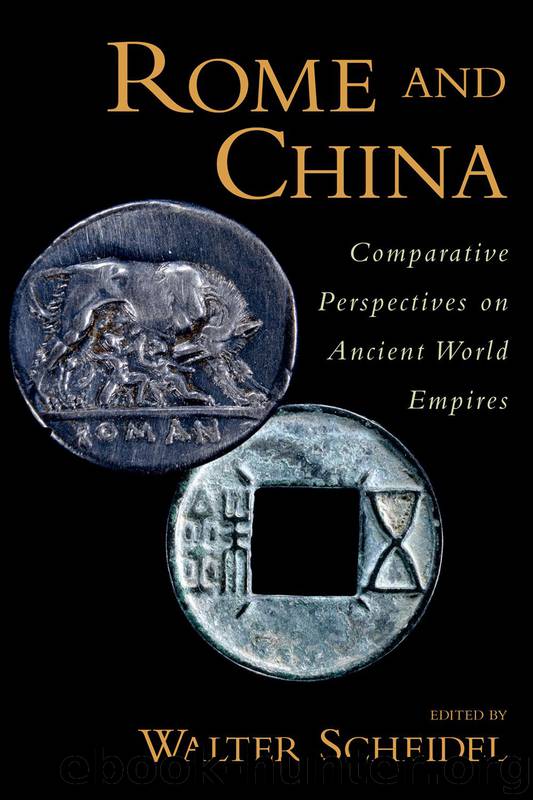Rome and China by Scheidel Walter;

Author:Scheidel, Walter;
Language: eng
Format: epub
Publisher: Oxford University Press USA - OSO
Published: 2012-08-08T16:00:00+00:00
3. CONCLUSION
“Gift,” as many scholars have noted, is not always an analytically useful term. It is necessary to distinguish various types of gift circulation or charity, because the types of goods that are conventionally given and the roles that are defined in their giving and receiving will mark the difference between two cultures. Thus, as noted above, Veyne emphasizes the contrast between Christian charity, which would become the standard model of giving in late antiquity, and classic euergetism. The latter is defined as gifts to a public realm that would be potentially received by all members of that realm. Indeed, the collective gifts of the elite to the common good are in some sense constitutive of the public realm, as a cluster of constructed spaces that would not otherwise exist, as a set of distinctive virtues (“public spirit”), and as a series of personal relationships defined on the model of patron and client. In this way we can see how in the ancient Mediterranean world particular modes of distributing wealth, distinct from market transactions, defined first the city–state and later the empire as distinctive public forms, and how these would be replaced by yet another form in the Christianized world.
In the Han Chinese case the public realm was not clearly distinguished from the political, so that participation in a res publica meant to be in the service of the ruler. (The same sort of pun/homophone gloss by which Cicero defined the “republic” could also be done in Chinese, where what was “public” [gong] was what pertained to the “lord” [gong].) Thus, it was above all the gift of titles by which the ruler brought all free men into his service and granted them corresponding legal privileges that constituted a broader “public” space. The other associated gifts, as noted above, were primarily extensions of policies aimed at preserving this political space defined by the participation of a free–holding peasantry.
The clear emergence of a realm in which local rural order was defined and maintained through the conspicuous charity and public–spirited actions of powerful families was to a certain degree the reflection of the breakdown of the earlier “imperial” model. This breakdown was marked by the parallel abandonment of universal military service and of all attempts to restrict the concentration of land ownership at the beginning of the Eastern Han and followed shortly by the eclipse of the old system of public ranking through the emperor’s gift of titles. This shift from the imperial realm defined by the emperor’s bestowal of ranks to one based on flow of gifts through circles of local charity indicated the replacement of a military–bureaucratic model of the state by a state–family union, in which the state order was transmitted and preserved through powerful local families. This shift toward a semipublic realm defined by an uneasy joining of a reduced political state with an extended kin and village hybrid defined the shift from the early imperial (Qin–Han) era to the centuries of the Northern and Southern Dynasties.
Download
This site does not store any files on its server. We only index and link to content provided by other sites. Please contact the content providers to delete copyright contents if any and email us, we'll remove relevant links or contents immediately.
| Africa | Americas |
| Arctic & Antarctica | Asia |
| Australia & Oceania | Europe |
| Middle East | Russia |
| United States | World |
| Ancient Civilizations | Military |
| Historical Study & Educational Resources |
The Daily Stoic by Holiday Ryan & Hanselman Stephen(3116)
The Fate of Rome: Climate, Disease, and the End of an Empire (The Princeton History of the Ancient World) by Kyle Harper(2882)
People of the Earth: An Introduction to World Prehistory by Dr. Brian Fagan & Nadia Durrani(2620)
Ancient Worlds by Michael Scott(2501)
Babylon's Ark by Lawrence Anthony(2435)
Foreign Devils on the Silk Road: The Search for the Lost Treasures of Central Asia by Peter Hopkirk(2389)
The Daily Stoic by Ryan Holiday & Stephen Hanselman(2353)
India's Ancient Past by R.S. Sharma(2307)
MOSES THE EGYPTIAN by Jan Assmann(2283)
The Complete Dead Sea Scrolls in English (7th Edition) (Penguin Classics) by Geza Vermes(2146)
Lost Technologies of Ancient Egypt by Christopher Dunn(2115)
The Earth Chronicles Handbook by Zecharia Sitchin(2105)
24 Hours in Ancient Rome by Philip Matyszak(1977)
Alexander the Great by Philip Freeman(1967)
Aztec by Gary Jennings(1883)
The Nine Waves of Creation by Carl Johan Calleman(1787)
Curse Tablets and Binding Spells from the Ancient World by Gager John G.;(1773)
Before Atlantis by Frank Joseph(1743)
Earthmare: The Lost Book of Wars by Cergat(1719)
